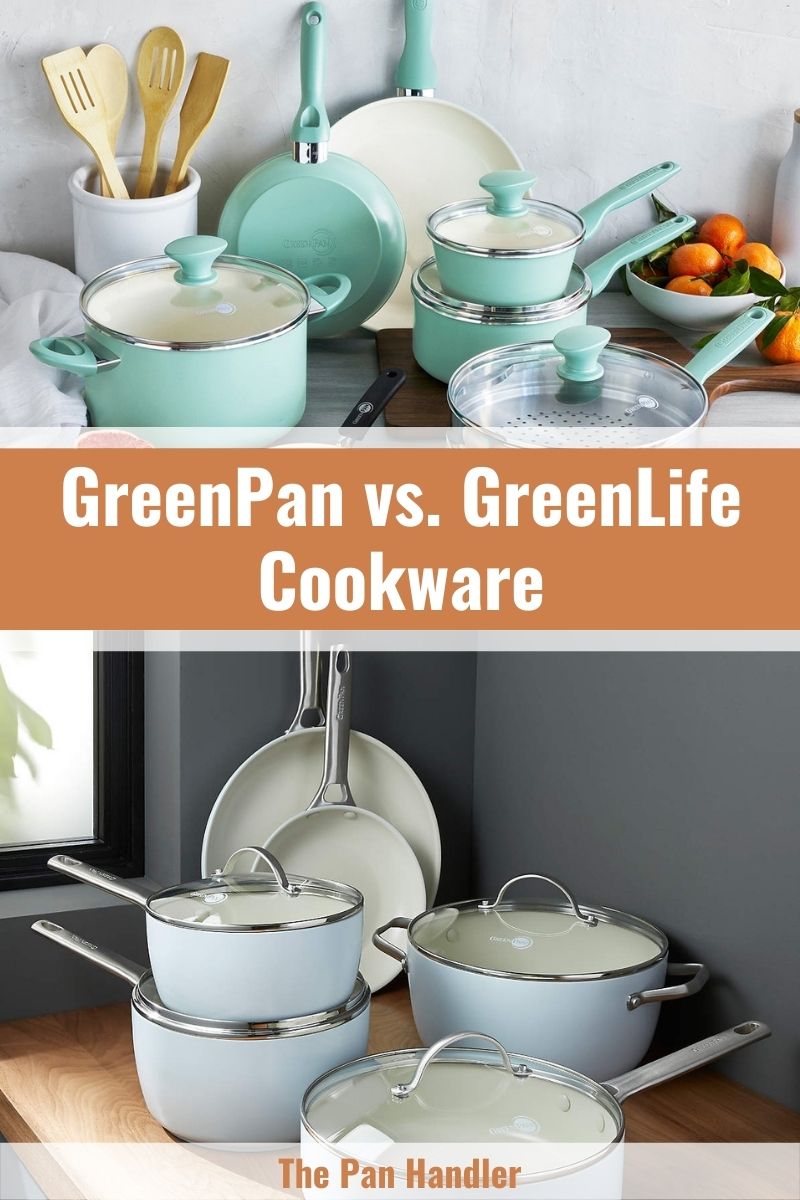Which would you choose: GreenPan or GreenLife? They share the same parent corporation and have similar missions. So, which one is the better fit for you? Today you’ll uncover the similarities and differences between the two cookware companies in this article.
Similarities Between GreenPan and GreenLife
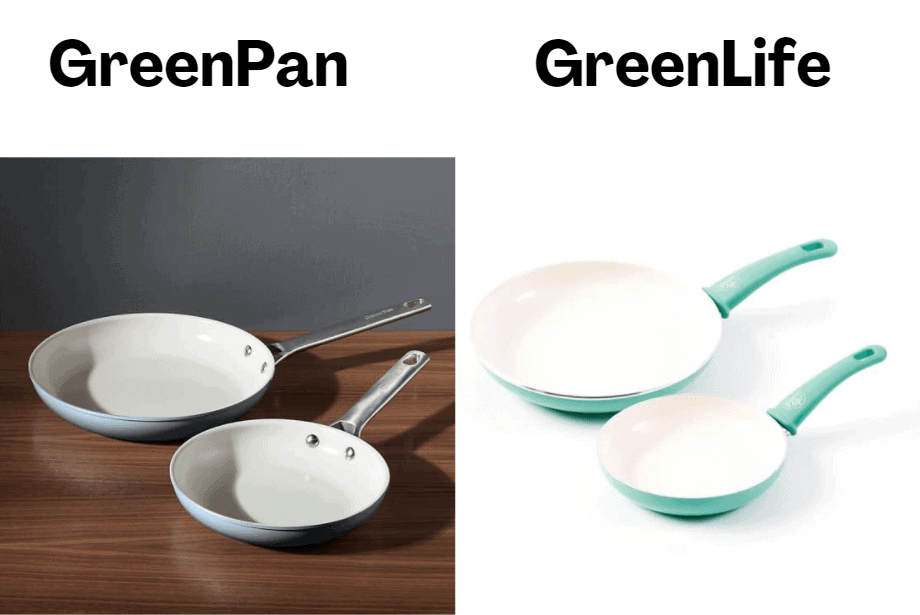
Before we go into detail about the similarities between the two cookware brands, take a look at the table below for a brief comparison.
| Features | GreenPan | GreenLife |
| Ownership | The Cookware Company | The Cookware Company |
| Mission | To bring healthy cooking within everyone’s reach | Healthy cookware and smart technologies |
| Place of Manufacture | China | China |
| Cleaning | Handwashing | Handwashing |
| Design | Colorful elements | Colorful exteriors |
| Base Material | Aluminum | Aluminum |
Ownership
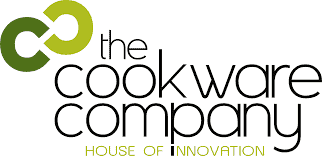
The Cookware Company owns both GreenLife and GreenPan. This multinational business with factories and offices worldwide is based in Belgium.
The company’s key assets include GreenLife and GreenPan, although all its brands promote “innovative cookware.”
GreenPan was founded in 2007 with an emphasis on eco-friendly production. It introduced Thermolon, a proprietary non-stick ceramic coating.
GreenPan is a Belgian firm that continues to design all its cookware in Belgium. They do, however, outsource the production to China.
On the other hand, GreenLife is a sister company to GreenPan. Similarly, GreenLife cookware lines are made in China.
Mission
Both companies share environment-focused missions.
GreenLife’s main goal is to make healthy cooking accessible for everyone, emphasizing that healthy cookware is a necessity, not an option. It also takes pride in its growing technologies.
Both companies use a natural non-stick coating that’s healthier than regular non-stick. According to them, this technique emits 60% less carbon dioxide than typical non-stick coatings.
Place of Manufacture
As mentioned above, GreenLife and GreenPan both make their products in China. They even share facilities in some instances.
Cleaning
Both brands label their sets as dishwasher-safe. However, both encourage handwashing to extend the lifespan of the products. It will also save you money in the long run.
Both cookware sets are easy to clean if the non-stick surfaces are maintained. But special care applies to Thermolon coatings.
Wait until the pots or pans are completely cool before cleaning them. Then, using warm water and mild soap, wash the items.
Dry the cookware using a soft towel to remove any residues. If you find any brown stains, use a sponge and fresh vegetable oil to clean them.
Differences Between GreenPan vs. GreenLife
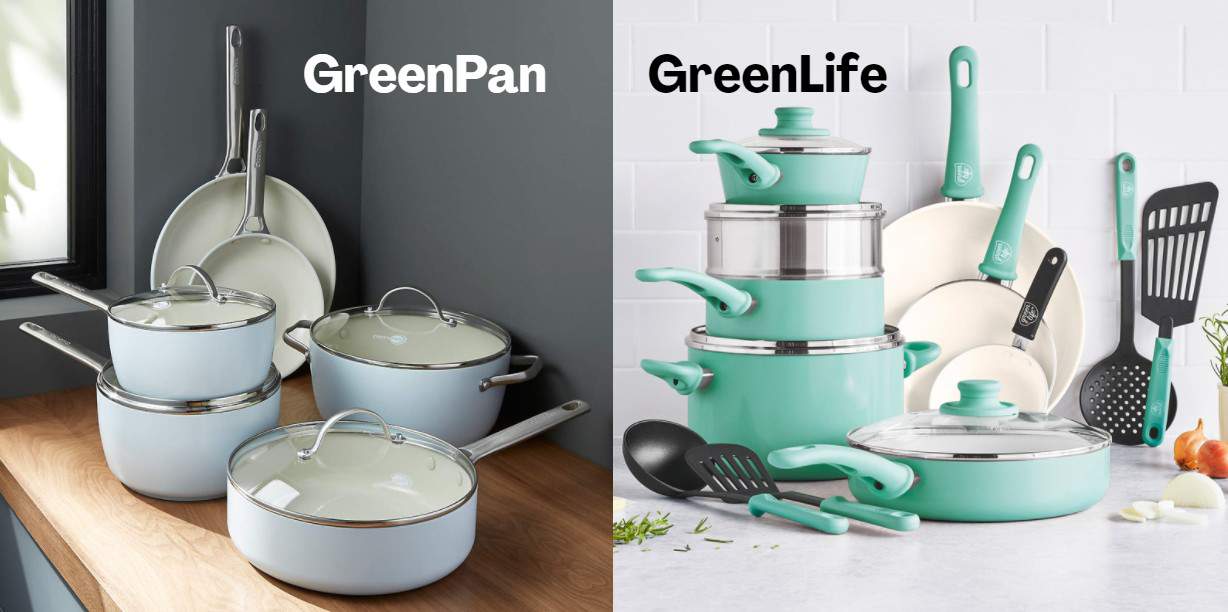
Now that you’ve learned about the similarities and differences between GreenPan and GreenLife, it’s time to dig deeper into the differences.
Construction
GreenPan offers three types of cookware: hard-anodized aluminum, regular aluminum, and full-clad stainless steel.
The stainless-steel lines sport a stunning steel exterior similar to luxury brands like All-Clad. Furthermore, the steel is coated with aluminum to quickly and evenly conduct heat.
Stainless steel is known for its resistance to rust, adaptability, incredible heat retention, and excellent conductivity. However, heat discoloration is unavoidable because of its weak resilience to burn stains.
To address this problem, GreenPan developed a new treatment called “Evershine.” It generates a protective coating against heat discoloration while retaining the glossy surface.
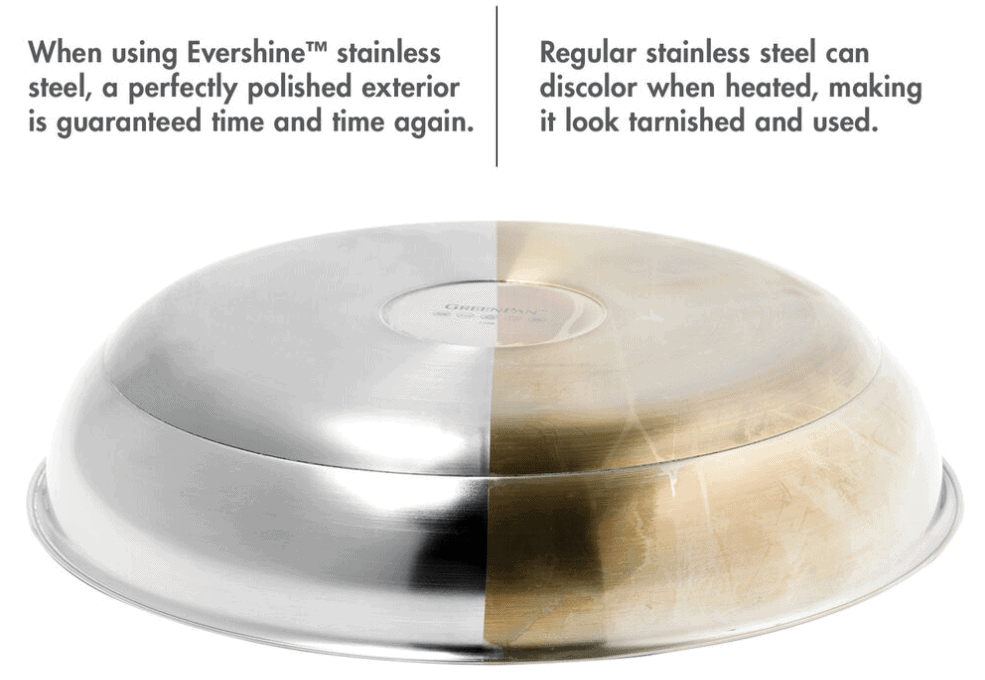
On the other hand, GreenLife cookware comes with standard aluminum. A hard-anodized aluminum base is only available in the GreenLife Classic set.
GreenLife obtains the aluminum it needs for its cookware by recycling cans. The aluminum layer guarantees equal and consistent heat across the entire cooking surface.
GreenLife products have lighter construction and are ideal for chefs who dislike heavy cookware.
GreenPan and GreenLife both use Thermolon as a non-stick coating on their cookware regardless of the materials they used. It is sand-based and is free of any harmful substances such as PTFE and cadmium.
Durability
Both brands apply the same non-stick coating, but GreenPan decided to go a step further.
GreenPan released higher-end versions. These sets have the same Thermolon coating but were mixed with diamond or other minerals to improve their durability.
In contrast, GreenLife builds with high-quality materials and incorporates cutting-edge technologies.
Design
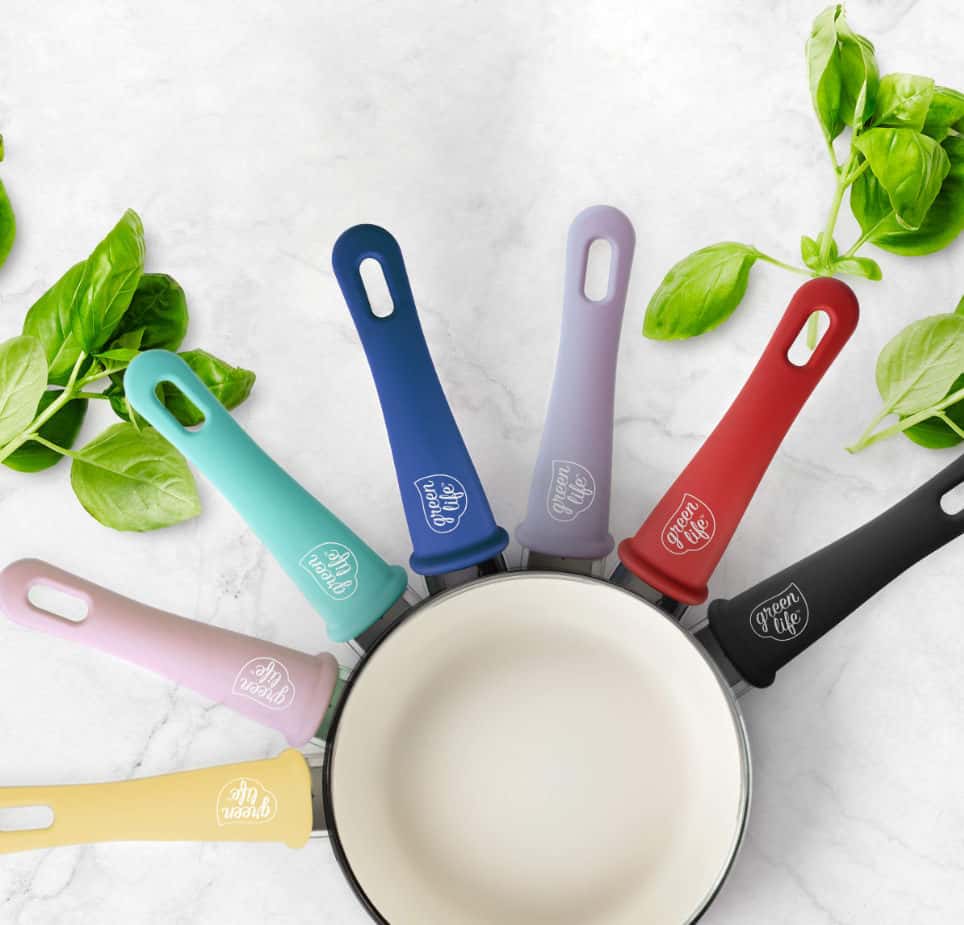
GreenPan has a limited color range and varies its styles in the handles and lids.
While GreenPan offers some vibrant colors, the Valencia Pro bundle is monochromatic, with a gray interior and exterior.
Contrarily, GreenLife comes in a whopping nine color options. It has a wide choice of cheerful colors, from pink to turquoise to yellow.
GreenLife promotes fun, but GreenPan focuses on efficiency and a modern look.
Handles and Lids
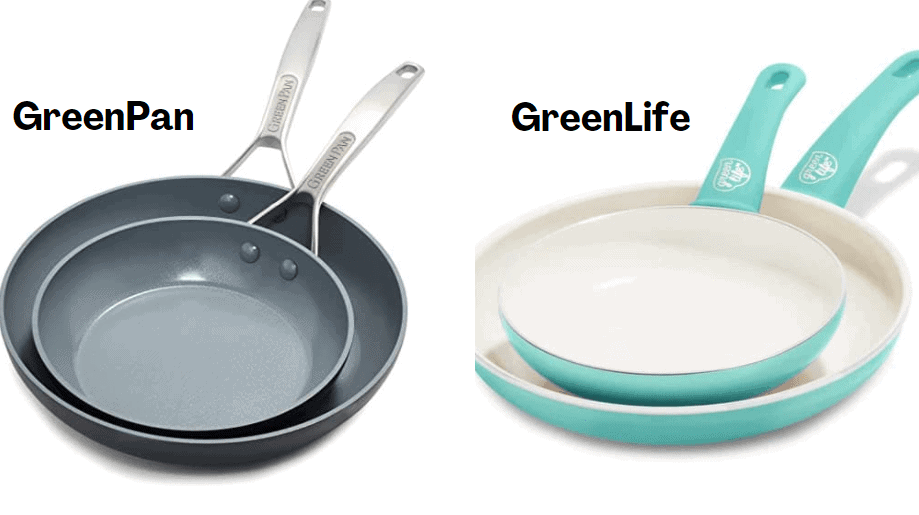
GreenPan cookware has straighter handles with a white plastic section near the back. The handles are made of double-riveted stainless-steel handles.
However, GreenLife collections sport soft, smooth, and rivet-less handles. Due to its lightweight nature, GreenLife provides proper and better handling.
Both brands use a U and V-shaped cut in their handles to decrease heat transfer. Both handles have a stay-cool function to keep them cool in high-temperature conditions.
In terms of lids, both sets come with sturdy glass lids.
Product Offerings
One big difference between GreenPan and GreenLife is their set inclusions. GreenPan provides ten different collections, whereas GreenLife has five only.
The table below shows GreenPan’s most popular sets:
| GreenPan Collections | Best Features |
| Valencia Pro | Diamond-reinforced coating |
| Venice Pro | Ergonomic handles and Evershine finish |
| Venice Pro Noir | Diamond-infused coating and non-corrosive handles |
| SmartShape | Optimal storage, rivet-less handles |
| Levels Hard Anodized | Ceramic non-stick and cabinet-friendly |
| Chatham | Contoured handles, hard-anodized bodies |
| Hudson | Retro look, Bakelite handles |
| Padova | Luxe feminine style |
| Barcelona Evershine | Evershine coating |
Now, check out the table below listing GreenLife collections.
| GreenLife Collections | Best Features |
| Soft Grip | Ergonomic, soft-grip silicone handles |
| Soft Grip Pro | Diamond-infused coating and silicone handles |
| Soft Grip Induction | Induction base cooktop |
| Classic Pro | Stainless steel handles |
| Minis | Two single-serving-sized items |
Induction Compatibility
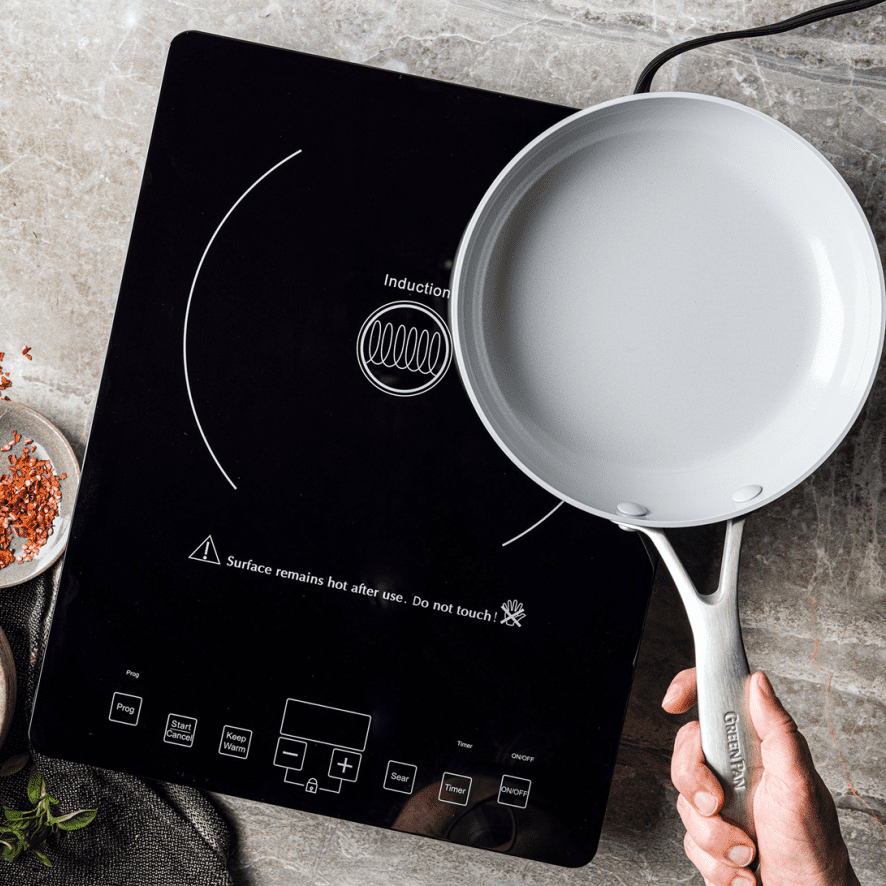
GreenPan has several induction-compatible collections. Among them are: Valencia Pro, Kitchen Stories, SmartShape, and all stainless-steel sets.
However, GreenLife has only one induction-compatible set, named The GreenLife Soft Grip Induction.
However, you must purchase the whole 15-piece set. You cannot buy one induction-compatible item only.
The set is only available in turquoise, limiting your options even more.
Any item that has a Magneto Induction Base is induction compatible. It’s a feature found in both GreenPan and GreenLife induction-safe lines.
Magneto helps keep the shape of cookware by controlling and quickly dispersing heat. It also keeps cookware from overheating.
Heat Tolerance
Although GreenPan and GreenLife products are safe in the oven, their tolerable temperatures differ dramatically.
GreenPan has prioritized oven safety so most GreenPan products can last until 600°F. This makes these items suitable for stove-to-oven recipes.
However, the temperature setting varies for every GreenPan collection.
Both Valencia Pro and GreenPan Paris collections can handle up to 600°F, while their glass lids can go in the oven up to 425°F.
The Hudson set is safe up to 320°F, while the lids can endure until 425°F.
The oven-safe temperatures for both the Soft-Grip and Rio collections are the same. They can go in the oven at 350°F.
You can put the Levels Hard-Anodized in the oven up to 400°F, but the lids can’t go beyond 350°F.
Most GreenLife items have Bakelite handles and cannot endure higher temperatures because the handles will melt.
Only the Classic Pro collection is safe up to 600°F. All other sets can handle up to 350°F only.
The heat-resistant handles are safe to a maximum temperature of 250°F only.
If you unintentionally overheat your cookware, you won’t have to worry about releasing toxins.
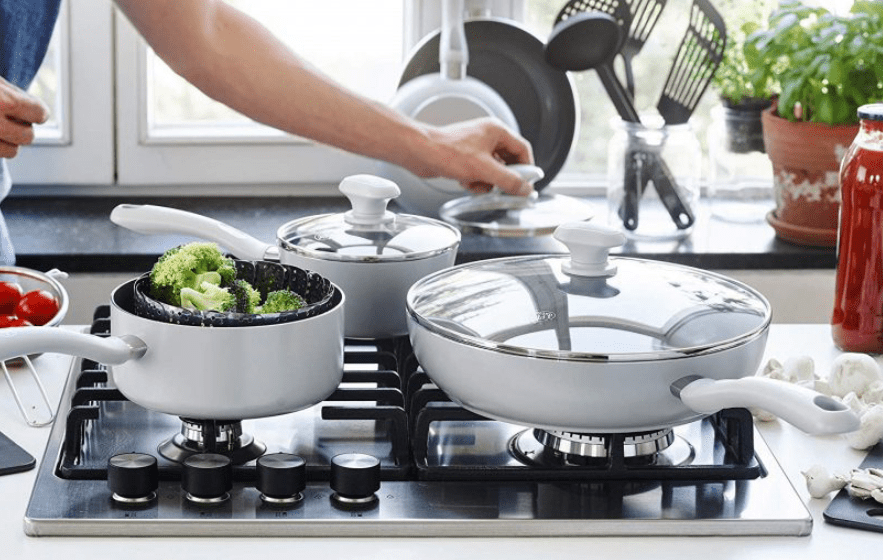
Performance
Both brands have excellent non-stick capabilities and smoothly release food. You can make a variety of meals using very little oil. This improves the nutritional value of the meal while also making washing easier.
The glass lids also make it simple to keep an eye on the food while cooking.
However, GreenLife is ideal for house cooks since it is light and easy to handle.
GreenPan items are heavier and more difficult to handle. But the riveted stainless-steel grips provide a firmer grasp and more stability.
Both brands claim you can use metal utensils, but better stick with wood, nylon, or plastic instead.
Versatility
Most Greenpan cookware will have larger capacities ideal for complicated dishes. They also come with a large casserole pot and a covered skillet.
In contrast, GreenLife pans and pots are smaller, perfect for most household cooking. Also, GreenLife cookware comes with an egg pan.
Both brands have similar-sized frying pans, but GreenLife features a mini-sized egg pan.
GreenLife Classic Pro Cookware also includes nylon utensils.
Price
There is a huge price difference between the two cookware brands.
GreenLife is the company’s entry-level non-stick brand, while GreenPan is the higher-tier version. Cookware prices vary depending on the merchant and location.
GreenLife is the most cost-effective option. It focuses solely on making safe sets for house cooks for under $100.
However, GreenPan creates high-end collections that cost over $400 for experienced chefs.
Summary
You are already familiar with the similarities and differences between GreenPan vs. GreenLife. They have the same parent company but are two different cookware brands selling eco-friendly products. They promote similar mission statements focusing on the environment and personal health. The question is, “Which cookware will you choose?”
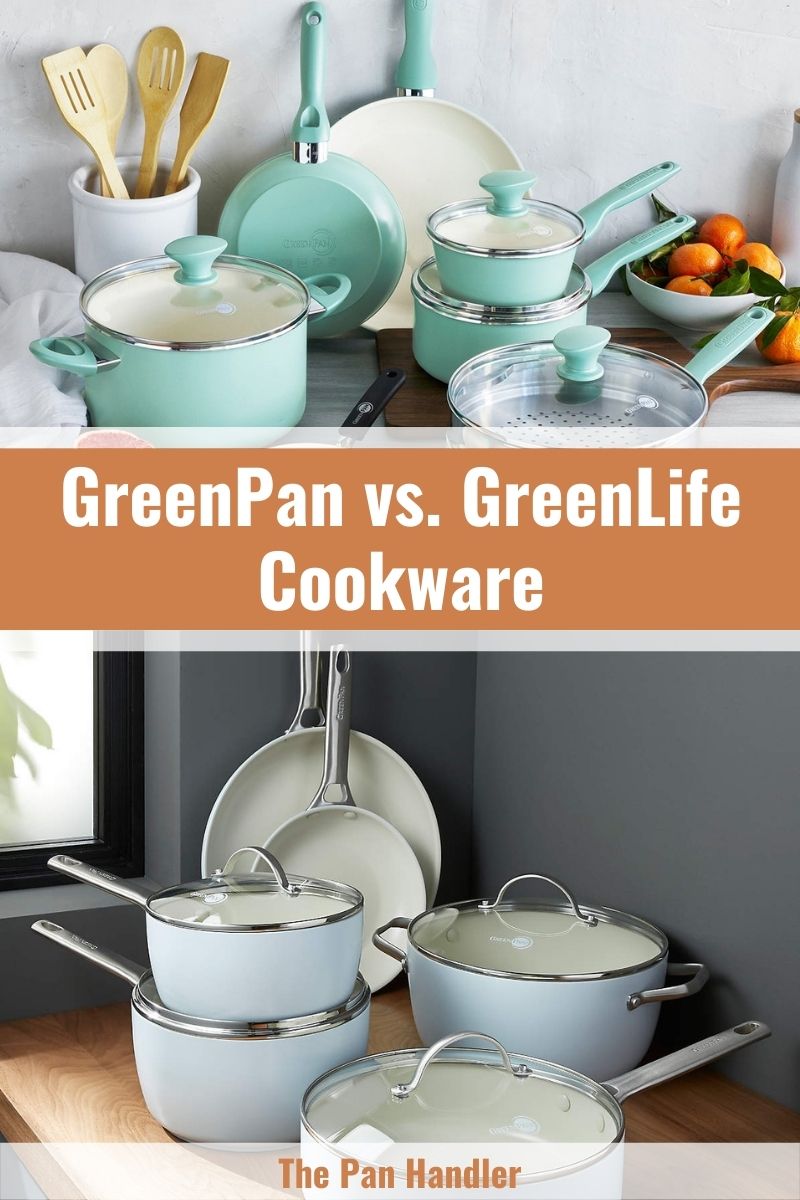

Michael Johnson is the founder of Pan Mastery, Inspired by his blacksmith grandfather’s legacy has a deep appreciation for hand-crafted pots and pans, he provides invaluable guides, reviews, and recipes to enhance your culinary journey.

